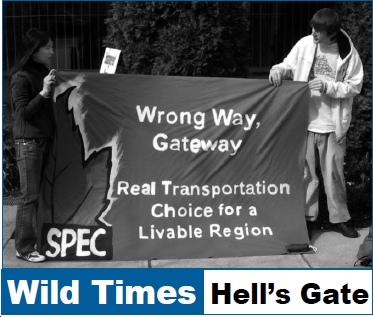Hell's Gate - Wild Times
Monday, May 14, 2007

May 15th, 2007 - Read Joe Foy's Wild Times column in the Watershed Sentinel as he grapples with the snarl of blacktop bearing down on Metro Vancouver.
By Joe Foy
In 1808 when fur trader Simon Fraser was being guided through Nlha’kapmx territory near present day Lytton BC, he could scarcely believe the network of ropes and ladders that made up the cliff trails at Hell’s Gate on the Fraser River. For Fraser, who was not familiar with life on the edge, it was a terrifying experience, but a necessary one as he sought to piece together a plan for trade and travel. In the end he was starved, nearly drowned, shot at by arrows and then finally figured out that he was on the wrong river – having believed for most of his journey that he was on the Columbia, instead of the river that we now know as the Fraser.
One of the only things that Fraser did know for sure by the end of his trip was that transportation planning is fraught with many difficulties and wrong turns – some of which can kill you.
It was just last winter that I felt a bit like old Simon Fraser, trying to make sense of a transportation plan being proposed for the Greater Vancouver Area by the BC government.
I was with a group of Wilderness Committee and SPEC volunteers standing outside of a Burnaby recreation centre holding a banner made out of a bed sheet. The snow was blowing down between the streetlights. Our little protest crew was shivering and stamping their feet as people filed in past us to a public meeting going on inside. The bed sheet banner read “Gateway? No Way! Say No to more traffic and sprawl – Say Yes to better public transit.” It was a big bed sheet.
Inside, government representatives were trying to sell Transportation Minister Kevin Falcon’s Gateway Plan to the locals. There were fancy charts and maps. Mostly what people
were being told was that by twinning the Port Mann Bridge and expanding the freeway, people in the Greater Vancouver Area would be able to get to and from work easier. And, as a bonus, because there would be less idling in traffic jams, our air quality would get better. You could tell that most people weren’t buying it by the incredulous looks on their faces.
Not a problem for Mr. Falcon’s consent factory. People were asked to fill out a form that gave them choices like “What colour should the bridges be?” or “What kind of bushes would you like next to the freeway interchange?” There was no question asking if the people actually wanted their bridges and highways super-sized. It was a little like being asked, “Do you want to be bonked with the yellow hammer or the red hammer?” Results according to governemnt: “Majority of people asked, want to be hit by hammer!”
As people came out of the public meeting we would talk with them. Most knew they were being taken for a ride. In Burnaby people were concerned about increased traffic pouring
through their side streets as a result of a beefed up freeway.
All through the rest of 2006 and 2007 we went from neighbourhood to neighbourhood, from Surrey to Delta to New Westminster, learning about the Gateway project and meeting the many citizen groups that had come together to oppose it.
What we found out was that Mr. Falcon’s Gateway project is way bigger than simply doubling the Port Mann Bridge and freeway.
The BC “Gateway Program,” combined with the Canadian “Pacific Gateway Strategy,” is a $7 billion attempt to capture Asia-Pacific trade. The Gateway projects include new and expanded highways, bridges, rail expansions, rail yards and container terminals to service a three-fold expansion of port facilities to accommodate three times more trucks moving container goods through the Greater Vancouver Regional District (GVRD) and across Canada.
You will pay $7 billion, plus interest, to build destructive transportation corridors through the GVRD, polluting the air you breathe and increasing climate changing greenhouse gas emissions. Moreover, the emissions from marine vessels, which have already increased 20% since 2000, are the leading source of smog-forming nitrogen oxides and cancer-causing pollutants. Deadly particulate matter, which has no safe level, is a principal component of diesel exhaust from ships and trucks. A single container ship belches more pollution than 2,000 diesel trucks. Gateway would triple container business and ensure 24-hour unrestricted movement of trucks, which would send even more of these deadly toxins into the GVRD airshed.
Gateway to Global Warming is a brand new newspaper from the Wilderness Committee about this insane Gateway plan and how we can stop it. You can read the whole thing on-line at wildernesscommittee.org.
Joe Foy is Campaign Director for the Wilderness Committee, Canada’s largest citizen-funded membership-based wilderness preservation organization.